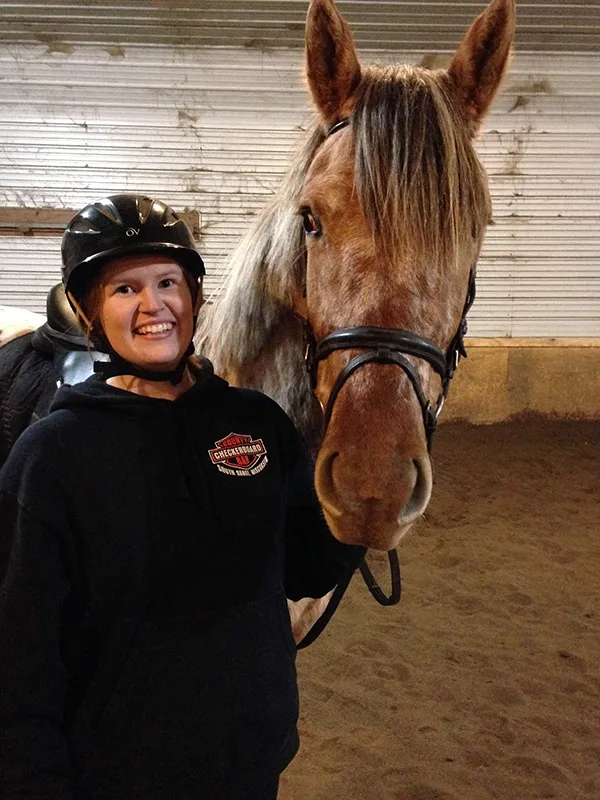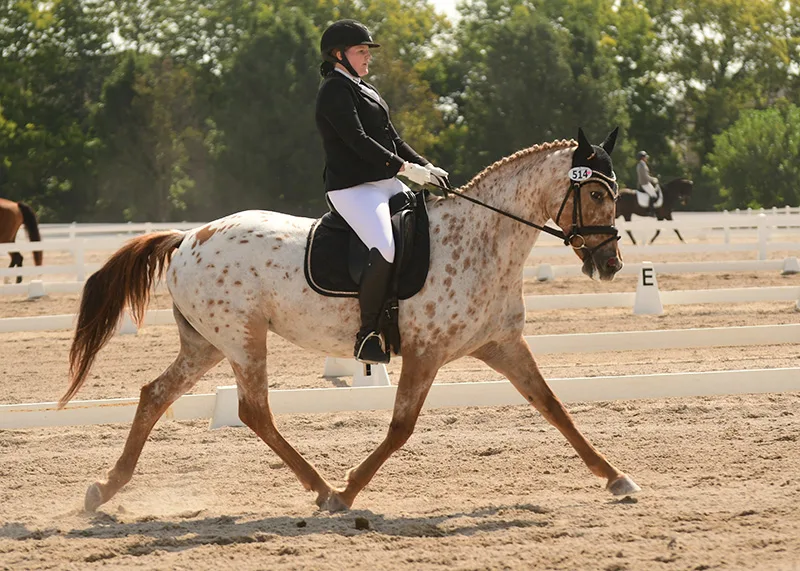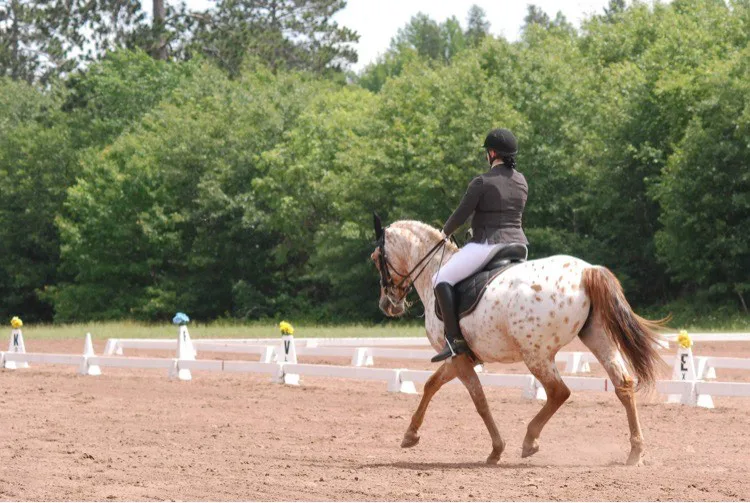Just before midnight on Dec. 2, 2017, Alicia Stock received a phone call from her dressage trainer Kate Phillips. Stock assumed the call was accidental and didn’t pick up, but when she listened to the voicemail moments later, her heart sank.
“Her voicemail said, ‘Alicia, I’m on my way out to the farm right now; it sounds like it’s Piper,” Stock recalled. “I just thought, ‘Oh my God, it’s my horse.’
“I called her back, and she told me that the vet was already on her way,” she continued. “They were speculating it was either a choke or colic at that point.”
Despite the hour, Stock’s best friend and housemate, Valeria Gift, insisted on driving her to Mississippi View Farm in Sauk Rapids, Minnesota. When they arrived, they found Piper standing in the indoor arena with their veterinarian, Dr. Donna Knevel, DVM.
“[Piper] is drenched; she is absolutely covered head to toe in sweat and had obviously been rolling,” Stock said. “And I knew: That’s not a choke.”
Just 8 years old, Piper, whose show name is Bright Design, never experienced so much as a sniffle in the three years Stock had owned her. The Friesian/Appaloosa cross (Grand Design—Bright Stormy Girl) was Stock’s first horse, and the pair had enjoyed a fairy-tale partnership, going from green through second level together and were beginning to school elements of third.
But for the next 10 days, it appeared Piper and Stock’s fairy tale might come to a tragic and premature ending.

Alicia Stock was all smiles after her first official ride as Bright Design’s owner in March 2014. Photo Courtesy Of Alicia Stock
Stock remembers the day in late 2013 when she first met Piper, a 5-year-old sales horse. Stock, who was helping at Mississippi View Farm, was asked to groom the hay-covered youngster.
“I vividly remember a friend looking at me and saying, ‘You know she’s for sale, right?’ ” Stock said with a laugh. “I was like, ‘No, no, I’ve just moved here; relocated. I can’t do that.’ But I would say, yes, I felt an instant connection with her.”
Though Stock had ridden dressage since age 12, her progress had been slow due to inconsistent access to both horses and instruction, and she had never competed.
After college, Stock relocated to St. Cloud, Minnesota, to begin her career as a respiratory therapist. She soon connected with Phillips and found what she describes as a true “farm family” at Mississippi View. But Stock had not intended to purchase a horse of her own.
“Being such a green-type rider, I should probably not have thought about buying a 5-year-old, but this was the right type of 5-year-old,” she said. “She was very quiet, very sweet, and had a solid year and a half of training underneath her.”
In June 2014, they made their competitive debut. That fall they competed at the GAIG/USDF Region 4 Championships (Iowa) in the adult amateur training level championship.
Over the next several years, they moved steadily up the levels, competing at the GAGI/USDF Region 4 Championships annually through 2017. They even began dabbling with musical freestyle, competing at both first and second levels with music chosen from Disney classics like “Frozen” and “Brave.”
“It was a lot of fun,” Stock said. “She taught me so much about showing, and I started finally doing what I’d always considered ‘real dressage,’ which is second level. Everywhere we went, she always kept such a quiet, sound mind in everything we did. Nothing seemed to bother her—she was such a good first horse.”

Alicia Stock and Piper competing at the 2022 GAIG/USDF Region 4 Championships (Mo.). Kathleen Bryan Photo
Stock still becomes teary-eyed thinking about the night Piper colicked. Knevel told Stock that the mare’s only chance of survival was a referral to the University of Minnesota’s Leatherdale Equine Center, a nearly hour and a half drive south.
“My husband and I talked about insuring her once we put the changes on her, and she was third level confirmed,” Stock said. “So, she was this uninsured horse staring me in the eyes. I knew I couldn’t afford surgery; I didn’t even know if I could even haul her to the [university].”
ADVERTISEMENT
That’s when Stock’s “farm family” truly stepped up. Gift, who had driven her to the barn, offered to help pay for Piper’s care, including surgery, while Phillips and her assistant prepared to load Piper into the trailer. While enroute the hospital, Stock received valued words of comfort and advice from another barn friend, AnnMarie Hernick Brockhouse.
“I can’t say it enough—I couldn’t have done this without my farm family,” Stock said. “No one would realize how much you need it until you need it.”

Valeria Gift (left), with Alicia Stock at U.S. Dressage Finals (Ky.) in 2021, was a major part of the “farm family” that helped get Piper through her challenging colic episodes. Photo Courtesy Of Alicia Stock
At Leatherdale, the emergency team quickly assessed Piper’s vitals, and her heart rate was well over 100 beats per minute. After removing nearly a muck tub’s worth of fluids via nasogastric tube and completing an inconclusive ultrasound, the emergency team laid out Stock’s options.
The mare had very poor odds of recovery if they simply treated her medically, and better odds if they performed surgery.
“It’s not good either way, but that’s what we’re looking at,” Stock recalled the team telling her.
After hours of stress, Stock says this information made her final decision easy. She stepped away with Phillips and Gift to share her thoughts.
“I told them, ‘She is an 8-year-old, really healthy mare,’ ” Stock said. “She is pretty sound-minded, and if anybody can make it through recovery, it’s this horse. We owe it to her to at least try.”
Dr. Fausto Bellezzo, DVM, DACVS, led the surgical team who discovered the cause of Piper’s colic was nephrosplenic entrapment, where the left large colon gets entrapped over the nephrosplenic ligament.
The procedure and first 24 hours went so smoothly that Bellezzo predicted Piper would be discharged in three days. But things soon took a downward turn.
“By Day 2, she wouldn’t eat,” Stock said. “She was refusing to drink, and we had her on continuous IV fluids. Then they hooked her up to sugar. We just had regression after regression.”

“Piper” at her lowest during her hospital stay, when she was refusing to eat or drink. Photo Courtesy Of Alicia Stock
The hospital tried every trick to stimulate Piper’s interest in eating; they made slurries and mashes, and took her for hand walks, while Stock brought hay and grain from home, as well as Piper’s favorite treats. Nothing seemed to perk her up. By the end of Day 5, the vets were running out of options—and Stock was running out of funds.
On Day 6, Bellezzo informed her Piper had colicked again overnight.
“He said, ‘It wasn’t bad, but it was big, and we did end up having to pump her stomach again,’ ” Stock said.
Gift drove Stock to the veterinary hospital, and Stock assumed she was heading there to say goodbye. When Stock entered Piper’s stall, the mare regarded her with a defeated expression, and Stock’s resolve broke.
“I had been keeping it together in front of her, and being very analytical and ‘medicine-y.’ as I call it,” she said. “But it was enough that I finally cried in her stall. I snapped, and the flood of Alicia’s tears was everywhere.”
Stock has no way to explain what happened next. Piper looked at her sobbing owner, walked over to her hay, and for the first time in five days, began eating.
“I’m not kidding—that happened,” Stock said. “Valeria and I stepped outside and sat there for 20 minutes, and the entire time, she kept eating.”
ADVERTISEMENT
The following day Piper returned to Mississippi View. As soon as she unloaded, Piper called to the other horses and tried to jog her way back into the barn.
“Looking back, we think she got depressed,” Stock said. “She was in ICU by herself, and she had never been anywhere alone. She always had horses around her. It was a rough first 24 hours at home, but she was back to eating, and looking more bright-eyed than she was down there.
“I looked at her and thought, ‘We might actually make it through this.’ ”
After three months of rest and gradually increased turnout, Stock received the green light for Piper to return to work under saddle. Piper acted as if she hadn’t missed a day—almost.
“She wasn’t sound,” Stock said. “This is typical, because they slice through all those muscles that pull the hind leg forward. It was a matter of needing to rebuild the strength.”
Under Phillips’ watchful eye, Stock worked to rebuild Piper’s suppleness, strength and range of motion. She admits the process was challenging at times, because for every step forward, it seemed there were two steps back.
“When things would go well, you would celebrate the little things,” she said, “and when you found something that wasn’t quite as good, you did your best to overcome it to make it better.”
The process was an eye-opening one for Stock.
“[I realized] I created so many holes the first time through on my horse,” she said. “The second round, I was particular on making sure everything was done correctly, because I knew more. And I was doing it for her benefit at that point, too.”
Nearly nine months after her surgery, Piper returned to the show ring. In August 2018, Stock performed a second level freestyle set to new music, chosen to highlight the spirit of friendship and love. It was a tribute to the farm family who had helped save Piper.
Since returning to the competitive arena, Piper’s star has continued to rise. The pair debuted at third level in 2019, and Stock completed her USDF bronze medal. In 2021, they qualified for the U.S. Dressage Finals (Kentucky) in the third level freestyle adult amateur championship, an honor they repeated in 2022.

Alicia Stock and Piper with trainer Kate Phillips at the show where the pair earned their bronze medal. Photo Courtesy Of Alicia Stock
“To get to Nationals was my version of the Olympics,” Stock said. “As I rode around the Alltech [Arena] for the first time, my eyes started to mist over. I was just in awe that I got to be there.”
Stock and Piper tackled fourth level in 2022, and are aiming for Prix St. Georges in 2023. And while Stock is grateful to still have her uniquely colored dance partner, she admits that she also has mixed emotions when she thinks back to Piper’s illness.
“I don’t begrudge what happened, but I would think twice before doing it again,” she said. “It was so hard on Piper during those 10 days, and I do still struggle with the thought that I forced that poor horse to do that for me. But I don’t think what I did was the wrong decision in the end. All of that work that the university did, and that the farm did, has given me all these extra years with Piper.”
Do you know a horse or rider who returned to the competition ring after what should have been a life-threatening or career-ending injury or illness? Email Kimberly at kloushin@coth.com with their story.















